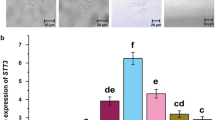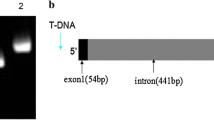Abstract
Ferric reductases are integral membrane proteins involved in the reduction of environmental ferric iron into the biologically available ferrous iron. In the most overwhelming phytopathogenic fungus, Verticillium dahliae, these ferric reductase are not studied in details. In this study we explored the role of FreB gene (VDAG_06616) in the ferric reduction and virulence of V. dahliae by generating the knockout mutants (ΔFreB) and complementary strains (ΔFreB-C) using protoplast transformation. When cultured on media supplemented with FeSO4, FeCl3 and no iron, ΔFreB exhibited significantly reduced growth and spore production especially on media with no iron. Transmembrane ferric reductase activity of ΔFreB was decreased up to 50% than wild type strains (Vd-wt). The activity was fully restored in ΔFreB-C. Meanwhile, the expression levels of other related genes (Frect-4, Frect-5, Frect-6 and Met) were obviously increased in ΔFreB. Compared with the Vd-wt and ΔFreB-C, ΔFreB-1 and ΔFreB-2 were impaired in colony diameter and spore number on different carbon sources (starch, sucrose, galactose and xylose). ΔFreB-1 and ΔFreB-2 were also highly sensitive to oxidative stress as revealed by the plate diffusion assay when 100 µM H2O2 was applied to the fungal culture. When Nicotiana benthamiana plants were inoculated, ΔFreB exhibited less disease symptoms than Vd-wt and ΔFreB-C. In conclusion, the present findings not only indicate that FreB mediates the ferric metabolism and is required for the full virulence in V. dahliae, but would also accelerate future investigation to uncover the pathogenic mechanism of this fungus.








Similar content being viewed by others
References
Achard MES, Chen KW, Sweet MJ, Watts RE, Schroder K, Schembri MA, Mcewan AG (2013) An antioxidant role for catecholate siderophores in Salmonella. Biochem J 454:543–549
Blatzer M, Binder U, Haas H (2011) The metalloreductase FreB is involved in adaptation of Aspergillus fumigatus to iron starvation. Fungal Genet Biol 48:1027–1033
Cadieux B, Lian T, Hu G, Wang J, Biondo C, Teti G, Liu V, Murphy MEP, Creagh AL, Kronstad JW (2013) The mannoprotein cig1 supports iron acquisition from heme and virulence in the pathogenic fungus Cryptococcus neoformans. J Infect Dis 207:1339–1347
Chen C, Noble SM (2012) Post-transcriptional regulation of the Sef1 transcription factor controls the virulence of Candida albicans in its mammalian host. PLoS Pathog 8:e1002956
Chen LH, Yang SL, Chung KR (2014) Resistance to oxidative stress via regulating siderophore-mediated iron acquisition by the citrus fungal pathogen Alternaria alternata. Microbiology 160:970–979
Chen JY, Xiao HL, Gui YJ, Zhang DD, Li L, Bao YM, Dai XF (2016) Characterization of the Verticillium dahliae exoproteome involves in pathogenicity from cotton-containing medium. Front Microbiol 7:1709–1720
Dancis A, Klausner RD, Hinnebusch AG, Barriocanal JG (1990) Genetic evidence that ferric reductase is required for iron uptake in Saccharomyces cerevisiae. Mol Cell Biol 10:2294–2301
Eisendle M, Schrettl M, Kragl C, Muller D, Illmer P, Haas H (2006) The intracellular siderophore ferricrocin is involved in iron storage, oxidative-stress resistance, germination, and sexual development in Aspergillus nidulans. Eukaryot Cell 5:1596–1603
Fisher MC, Henk D, Briggs CJ, Brownstein JS, Madoff LC, McCraw SL, Gurr SJ (2012) Emerging fungal threats to animal, plant and ecosystem health. Nature 484:186–194
Fradin EF, Thomma BPHJ (2006) Physiology and molecular aspects of Verticillium wilt diseases caused by V. dahliae and V. albo-atrum. Mol Plant Pathol 7:71–86
Guerinot ML, Yi Y (1994) Iron: nutritious, noxious, and not readily available. Plant Physiol 104:815–820
Han Q, Wu F, Wang X, Qi H, Shi L, Ren A, Liu Q, Zhao M, Tang C (2015) The bacterial lipopeptide iturins induce Verticillium dahliae cell death by affecting fungal signaling pathways and mediate plant defence responses involved in pathogen-associated molecular pattern-triggered immunity. Environ Microbil 17:1166–1188
Hillmann F, Shekhova E, Kniemeyer O (2015) Insights into the cellular responses to hypoxia in filamentous fungi. Curr Genet 61:441–455
Homann OR, Dea J, Noble SM, Johnson AD (2009) A phenotypic profile of the Candida albicans regulatory network. PLoS Genet 5:e1000783
Hoppenau CE, Tran VT, Kusch H, Aßhauer KP, Landesfeind M, Meinicke P, Popova B, Braus-Stromeyer SA, Braus GH (2014) Verticillium dahliae VdTHI4, involved in thiazole biosynthesis, stress response and DNA repair functions, is required for vascular disease induction in tomato. Environ Exp Bot 108:14–22
Huang LS, Lin KC (2001) Detection of iron species using inductively coupled plasma mass spectrometry under cold plasma temperature conditions. Spectrochim Acta Part B At Spectrosc 56:123–128
Imlay JA (2003) Pathways of oxidative damage. Annu Rev Microbiol 57:395–418
Klimes A, Dobinson KF (2006) A hydrophobin gene, VDH1, is involved in microsclerotial development and spore viability in the plant pathogen Verticillium dahliae. Fungal Genet Biol 43:283–294
Kumar S, Stecher G, Tamura K (2016) MEGA7: molecular evolutionary genetics analysis version 7.0 for bigger datasets. Mol Biol Evol 33:1870–1874
Lee JY, Lee HS, Song JY, Jung JY, Reinbothe S, Park Y, Lee SY, Pai HS (2013) Cell growth defect factor1/chaperone-like protein of POR1 plays a role in stabilization of light-dependent protochlorophyllide oxidoreductase in Nicotiana benthamiana and Arabidopsis. Plant Cell 25:3944–3960
Liu SY, Chen JY, Wang JL, Li L, Xiao HL, Adam SM, Dai XF (2013) Molecular characterization and functional analysis of a specific secreted protein from highly virulent defoliating Verticillium dahliae. Gene 529:307–316
McCotter SW, Horianopoulos LC, Kronstad JW (2016) Regulation of the fungal secretome. Curr Genet 62:533–545
Meneghini R (1997) Iron homeostasis, oxidative stress, and DNA damage. Free Radic Biol Med 23:783–792
Moore MM (2013) The crucial role of iron uptake in Aspergillus fumigatus virulence. Curr Opin Microbiol 16:692–699
Morrissey JA, Williams PH, Cashmore AM (1996) Candida albicans has a cell-associated ferric-reductase activity which is regulated in response to levels of iron and copper. Microbiology 142:485–492
Nyhus KJ, Wilborn AT, Jacobson ES (1997) Ferric iron reduction by Cryptococcus neoformans. Infect Immun 65:434–438
Oerke EC (2006) Crop losses to pests. J Agric Sci 144:31–43
Pegg GF, Brady BL (2002) Verticillium Wilts. CABI Pulishing, New York
Pennisi E (2010) Armed and dangerous. Science 327:804–805
Pepper SE, Borkowski M, Richmann MK, Reed DT (2010) Determination of ferrous and ferric iron in aqueous biological solutions. Anal Chim Acta 663:172–177
Philpott CC (2006) Iron uptake in fungi: a system for every source. Biochim Biophys Acta Mol Cell Res 1763:636–645
Qi X, Su X, Guo H, Qi J, Cheng H (2016) VdThit, a thiamine transport protein, is required for pathogenicity of the vascular pathogen Verticillium dahliae. Mol Plant Microbe Interact 29:545–559
Rehman L, Su X, Guo H, Qi X, Cheng H (2016) Protoplast transformation as a potential platform for exploring gene function in Verticillium dahliae. BMC Biotechnol 16:57–65
Saikia S, Oliveira D, Hu G, Kronstad J (2014) Role of ferric reductases in iron acquisition and virulence in the fungal pathogen Cryptococcus neoformans. Infect Immun 82:839–850
Su X, Rehman L, Guo H, Li X, Zhang R, Cheng H (2017) AAC as a potential target gene to control Verticillium dahliae. Genes (Basel) 8:25–41
Sutak R, Lesuisse E, Tachezy J, Richardson DR (2008) Crusade for iron: iron uptake in unicellular eukaryotes and its significance for virulence. Trends Microbiol 16:261–268
Tran V, Braus-Stromeyer SA, Kusch H, Reusche M, Kaever A, Kuhn A, Valerius O, Landesfeind M, Aßhauer K, Tech M, Hoff K, Pena-Centeno T, Stanke M, Lipka V, Braus GH (2014) Verticillium transcription activator of adhesion Vta2 suppresses microsclerotia formation and is required for systemic infection of plant roots. New Phytol 202:565–581
Tzima AK, Paplomatas EJ, Tsitsigiannis DI, Kang S (2012) The G protein B subunit controls virulence and multiple growth- and development-related traits in Verticillium dahliae. Fungal Genet Biol 49:271–283
Wang HM, Lin ZX, Zhang XL, Chen W, Guo XP, Nie YC, Li YH (2008) Mapping and quantitative trait loci analysis of Verticillium wilt resistance genes in cotton. J Integr Plant Biol 50:174–182
Wang Y, Liang C, Wu S, Zhang X, Tang J, Jian G, Jiao G, Li F, Chu C (2016) Significant improvement of cotton Verticillium wilt resistance by manipulating the expression of gastrodia antifungal proteins. Mol Plant 9:1436–1439
Weber KA, Achenbach LA, Coates JD (2006) Microorganisms pumping iron: anaerobic microbial iron oxidation and reduction. Nat Rev Microbiol 4:752–764
Xiong D, Wang Y, Tang C, Fang Y, Zou J, Tian C (2015) VdCrz1 is involved in microsclerotia formation and required for full virulence in Verticillium dahliae. Fungal Genet Biol 82:201–212
Xiong D, Wang Y, Tian L, Tian C (2016) MADS-Box transcription factor VdMcm1 regulates conidiation, microsclerotia formation, pathogenicity, and secondary metabolism of Verticillium dahliae. Front Microbiol 7:1192–1206
Xu N, Qian K, Dong Y, Chen Y, Yu Q, Zhang B, Xing L, Li M (2014) Novel role of the Candida albicans ferric reductase gene CFL1 in iron acquisition, oxidative stress tolerance, morphogenesis and virulence. Res Microbiol 165:1–10
Yun CW, Bauler M, Moore RE, Klebba PE, Philpott CC (2001) The role of the FRE family of plasma membrane reductases in the uptake of siderophore-iron in Saccharomyces cerevisiae. J Biol Chem 276:10218–10223
Zhang YL, Li ZF, Feng ZL, Feng HJ, Zhao LH, Shi YQ, Hu XP, Zhu HQ (2015) Isolation and functional analysis of the pathogenicity-related gene VdPR3 from Verticillium dahliae on cotton. Curr Genet 61:555–566
Zhang DD, Wang XY, Chen JY, Kong ZQ, Gui YJ, Li NY, Bao YM, Dai XF (2016a) Identification and characterization of a pathogenicity-related gene VdCYP1 from Verticillium dahliae. Sci Rep 6:27979–27991
Zhang T, Jin Y, Zhao JH, Gao F, Zhou BJ, Fang YY, Guo HS (2016b) Host-induced gene silencing of target gene in fungal cells confers effective resistance to cotton wilt disease pathogen Verticillium dahliae. Mol Plant 9:939–942
Zhang WQ, Gui YJ, Short DPG, Li TG, Zhang DD, Zhou L, Liu C, Bao YM, Subbarao KV, Chen JY, Dai XF (2017) Verticillium dahliae transcription factor VdFTF1 regulates the expression of multiple secreted virulence factors and is required for full virulence in cotton. Mol Plant Pathol. https://doi.org/10.1111/mpp.12569
Zhao YL, Zhou TT, Duo HS (2016) Hyphodium-specific VdNoxB/VdPls 1-dependent ROS-Ca2+ signaling is required for plant infection by Verticillium dahliae. PLoS Pathog 12:e1005793
Acknowledgements
This work was supported by a grant from the National Natural Science Foundation of China (31772244), the National Nonprofit Industry Research (201503109) and the Agricultural Science and Technology Innovation Program of CAAS.
Author information
Authors and Affiliations
Corresponding author
Ethics declarations
Conflict of interest
The authors declare that they have no competing interests.
Additional information
Communicated by M. Kupiec.
Latifur Rehman and Xiaofeng Su contributed equally.
Electronic supplementary material
Below is the link to the electronic supplementary material.
Rights and permissions
About this article
Cite this article
Rehman, L., Su, X., Li, X. et al. FreB is involved in the ferric metabolism and multiple pathogenicity-related traits of Verticillium dahliae . Curr Genet 64, 645–659 (2018). https://doi.org/10.1007/s00294-017-0780-x
Received:
Revised:
Accepted:
Published:
Issue Date:
DOI: https://doi.org/10.1007/s00294-017-0780-x




